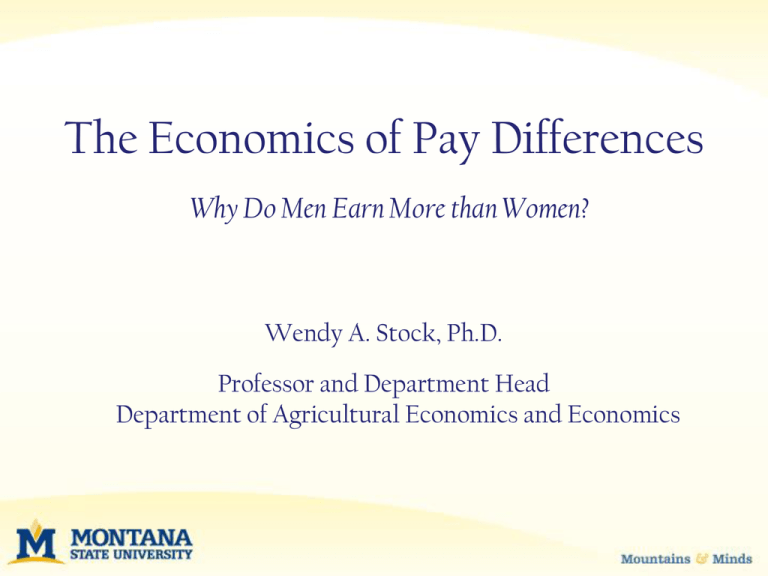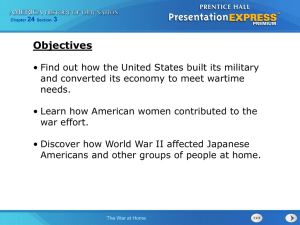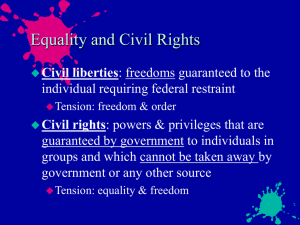
The Economics of Pay Differences
Why Do Men Earn More than Women?
Wendy A. Stock, Ph.D.
Professor and Department Head
Department of Agricultural Economics and Economics
Outline
Race, Gender, & Ethnicity in the Work Force
Pay Gaps Among People
Discrimination
Antidiscrimination Policy
Race, Gender, &
Ethnicity
Pay Gaps
Antidiscrimination
Policy
Discrimination
Race, Gender, and Ethnicity in the Work Force
1962
2012
Asian
5%
Other
10%
Other
2%
Black
12%
White
90%
2050
Other
5%
Asian
8%
Black
14%
White
81%
White
73%
Sources: U.S. Department of Labor, “Labor Force Characteristics by Race and Ethnicity, 2010” August 2011; Toossi, M. “A new look at long-term labor force projections to
2050,” Monthly Labor Review, November 2006; Pew Hispanic Center, “Hispanics: People in Motion,” 2005.
Race, Gender, &
Ethnicity
Pay Gaps
Discrimination
Antidiscrimination
Policy
Race, Gender, and Ethnicity in the Work Force
1962
Females
36%
2012
Females
47%
Males
64%
2050
Males
53%
Females
47%
Males
53%
Sources: U.S. Department of Labor, “Labor Force Characteristics by Race and Ethnicity, 2010” August 2011; Toossi, M. “A new look at long-term labor force projections to
2050,” Monthly Labor Review, November 2006; Pew Hispanic Center, “Hispanics: People in Motion,” 2005.
Race, Gender, &
Ethnicity
Pay Gaps
Discrimination
Antidiscrimination
Policy
Race, Gender, and Ethnicity in the Work Force
1980
Hispanic
6%
2012
Hispanic
14%
NonHispanic
94%
2050
Hispanic
24%
NonHispanic
86%
NonHispanic
76%
Sources: U.S. Department of Labor, “Labor Force Characteristics by Race and Ethnicity, 2010” August 2011; Toossi, M. “A new look at long-term labor force projections to
2050,” Monthly Labor Review, November 2006; Pew Hispanic Center, “Hispanics: People in Motion,” 2005.
Race, Gender, &
Ethnicity
Pay Gaps
Discrimination
Antidiscrimination
Policy
Pay Gaps & Earnings Ratios
Race, Gender, &
Ethnicity
Pay Gaps
Discrimination
Antidiscrimination
Policy
Pay Gaps & Earnings Ratios
A pay gap is the percent
difference in earnings
between two groups
An earnings ratio measures
the earnings of one group as
a fraction of the earnings of
another group
Race, Gender, &
Ethnicity
Pay Gaps
Antidiscrimination
Policy
Discrimination
Pay Gaps & Earnings Ratios
Pay Gaps Relative to White Males, 2011
Asian Female
-22
Asian Male
7
Black Female
-54
Black Male
Hispanic Female
-35
-73
Hispanic Male
-55
White Female
-24
-80
-70
-60
-50
-40
-30
-20
-10
0
10
Percent Difference from White Male Earnings
Source: BLS Current Population Survey Data. Includes ages 16+ employed full-time wage and salary workers across all industries and all occupations., excluding incorporated self-employed.
Hispanic male and female values are computed for any race. White, Black, and Asian values are computed for any ethnicity.
Race, Gender, &
Ethnicity
Pay Gaps
Discrimination
Antidiscrimination
Policy
Pay Gaps & Earnings Ratios
Earnings Ratios Relative to White Males, 2011
Asian Female
Asian Male
Black Female
Black Male
Hispanic
Female
Hispanic Male
White Female
White Male
0.00 0.10 0.20 0.30 0.40 0.50 0.60 0.70 0.80 0.90 1.00 1.10
Proportion of White Male Earnings
Source: BLS Current Population Survey Data. Includes ages 16+ employed full-time wage and salary workers across all industries and all occupations., excluding incorporated self-employed.
Hispanic male and female values are computed for any race. White, Black, and Asian values are computed for any ethnicity.
Race, Gender, &
Ethnicity
Pay Gaps
Discrimination
Antidiscrimination
Policy
Why Are There Pay Gaps?
Job Differences
Productivity-related Characteristics
Other Factors
Race, Gender, &
Ethnicity
Pay Gaps
Discrimination
Antidiscrimination
Policy
Job Differences
Management & Professional
Service
Sales & Office
Construction & Maintenance
Production & Transportation
Hispanic
Asian
Black
White
Women
Men
0%
20%
40%
60%
80%
Percent of Group in Each Occupation
Source: Author’s chart based on U.S. Department of Labor, “Labor Force Characteristics by Race and Ethnicity, 2010” Report 1032, August 2011.
100%
Race, Gender, &
Ethnicity
Pay Gaps
Discrimination
Antidiscrimination
Policy
Productivity-related Characteristics
Hispanic
Asian
Black
White
Bachelor's Degree or higher
Some College or Associate
Degree
High School Graduate, no
college
Less than High School Diploma
0
10
20
30
40
50
60
70
Percent of Demographic Group
Educational attainment differs among various race and ethnic groups. Over 60 % of Asians over age 25 who are in the labor force hold a Bachelor's degree or higher; less than 20% of Hispanics
with the same characteristics hold a Bachelor's degree or higher. Source: Author's calculations based on 2011 BLS data for people age 25 or older in the civilian labor force .
Race, Gender, &
Ethnicity
Pay Gaps
Discrimination
Antidiscrimination
Policy
Pay Gaps
Important to control for observable job and
productivity-related differences between groups
when interpreting pay gap data.
Race, Gender, &
Ethnicity
Pay Gaps
Discrimination
Antidiscrimination
Policy
Other Sources of Pay Gaps
Percent of Pay Gap
Percent of Pay Gap Due to Observable and Unobservable Factors
100%
90%
80%
70%
60%
50%
40%
30%
20%
10%
0%
Due to Observable Differences
Female-Male
Black-White
Due to Other Factors
Hispanic-non-Hispanic
Observable differences include age, education, marital status (for Hispanic comparison only), and region and occupation (for gender and race comparisons only) Sources: Altonji and
Blank (1999) “Race and Gender in the Labor Market,” in Ashenfelter and Card, eds. Handbook of Labor Economics, vol. 3C for race and sex comparisons. Kerr, Orrenius, and Zavodly
(2010) “Texas’ Latino Pay Gaps: Taking a Closer Look” SouthwestEconomy, Federal Reserve Bank of Dallas. Data for Hispanic-non-Hispanic gap are calculated within Texas only.
Race, Gender, &
Ethnicity
Pay Gaps
Discrimination
Antidiscrimination
Policy
Discrimination
differential treatment based on arbitrary
characteristic
Race, Gender, &
Ethnicity
Pay Gaps
Discrimination
Antidiscrimination
Policy
Types of Discrimination
Taste-based discrimination
when people have preferences
not to work with, hire, or buy
from the discriminated group
Statistical discrimination
when people use information about
the average characteristics of a
group to make decisions about an
individual member of that group
Race, Gender, &
Ethnicity
Pay Gaps
Discrimination
Antidiscrimination
Policy
Education Discrimination
Plessy v. Ferguson 1896
Brown v. Board of Education 1954
Persistent School Quality Differences
Elizabeth Eckford attempting to enter Little Rock High
Central School through a crowd of angry white students,
1957
School quality Resources: Eric Hanushek at Stanford’s Hoover Institution: http://hanushek.stanford.edu/publications/economics-school-quality-0
Boozer, Krueger, Wolkon (1992) “Race and School Quality Since Brown vs. Board of Education,” NBER working Paper 4109: http://www.nber.org/papers/w4109
Race, Gender, &
Ethnicity
Pay Gaps
Discrimination
Antidiscrimination
Policy
Housing Discrimination
Disabled housing discrimination: http://news.medill.northwestern.edu/chicago/news.aspx?id=206162
Boston: http://www.digitaljournal.com/article/326074#ixzz1wvwhFjlA
http://articles.chicagotribune.com/2012-06-01/business/chi-bridgeport-discrimination-suit-20120601_1_prudential-rubloff-properties-daniel-and-adrienne-sabbia-willborns
Race, Gender, &
Ethnicity
Pay Gaps
Discrimination
Antidiscrimination
Policy
Lending Discrimination
Pope, Devin G., and Justin R. Sydnor. 2011. “What’s in a Picture? Evidence of Discrimination from Prosper.com.” Journal
of Human Resources 46(1): 53–92.
Mortgage Lending Discrimination: http://www.dollarsandsense.org/archives/2010/1110campen.html
Race, Gender, &
Ethnicity
Pay Gaps
Discrimination
Antidiscrimination
Policy
Labor Market Discrimination
• equally productive workers treated differently
• workers not equally productive treated the same
Race, Gender, &
Ethnicity
Pay Gaps
Discrimination
Antidiscrimination
Policy
Employer Discrimination
when employers base their employment
decisions on prejudice against certain workers
Darity, W. A., and Mason, P. L. (1998) “Evidence on Discrimination in Employment: Codes of Color, Codes of Gender,” Journal of Economic Perspectives, 12(2):63-90. Presents an overview of the economic research
on race and gender discrimination in the labor market
Race, Gender, &
Ethnicity
Pay Gaps
Discrimination
Antidiscrimination
Policy
Customer Discrimination
when customers have base their purchasing
decisions on the race, sex, or other demographic
characteristics of the workers with whom they
interact
Race, Gender, &
Ethnicity
Pay Gaps
Discrimination
Antidiscrimination
Policy
Statistical Discrimination
using information about the average characteristics of a group
to judge an individual member of that group
Race, Gender, &
Ethnicity
Pay Gaps
Discrimination
Antidiscrimination
Policy
Antidiscrimination Policy
1964 Civil Rights Act
first federal legislation to prohibit
employment discrimination
Race, Gender, &
Ethnicity
Pay Gaps
Discrimination
Antidiscrimination
Policy
Antidiscrimination Policy
Affirmative action
policies that mandate taking action to ensure the equal
treatment of people regardless of their race, creed, color, or
national origin.
http://www.balancedpolitics.org/affirmative_action.htm
Race, Gender, &
Ethnicity
Pay Gaps
Discrimination
Antidiscrimination
Policy
Antidiscrimination Policy
Americans with Disabilities Act
Age Discrimination in Employment Act
Race, Gender, &
Ethnicity
Pay Gaps
Antidiscrimination
Policy
Discrimination
Antidiscrimination Policy Effects
Black/White Earnings Ratios
1.00
Black/White Median Earnings
Black Females/White Females
0.90
0.80
0.70
0.60
1967
Black Males/White Males
1972
1977
1982
1987
Year
1992
1997
2002
2007
If laws prohibiting race discrimination are effective, black/white earnings ratios should increase after the laws are passed, ceteris paribus. The black/white earnings ratios increased
after the mid-1960s, particularly for women. The black/white earnings ratios for men have remained fairly steady since the mid-1990s, but they declined slightly for women after the
1970s. Source: Author's computations based on U.S. Census Data. Includes median earnings of full-time year round workers 15 years old and over beginning in 1980, and 14
years old and over for previous years. Before 1989 earnings are for civilian workers only.
Race, Gender, &
Ethnicity
Pay Gaps
Antidiscrimination
Policy
Discrimination
Antidiscrimination Policy Effects
Female/Male Earnings Ratios
Female/Male Median Earnings
1.00
Black Females/Black Males
0.90
0.80
0.70
White Females/White Males
0.60
0.50
1967
1972
1977
1982
1987
1992
1997
2002
2007
Year
If laws prohibiting sex discrimination are effective, the female/male earnings ratios should increase after the laws are passed, ceteris paribus. The
female/male earnings ratios for blacks increased after the mid-1960s, but have flattened or declined since the early 1990s. The female/male earnings ratios
for whites have risen fairly steadily since the mid-1980s. Source: Author's computations based on U.S. Census Data. Includes median earnings of full-time
year round workers 15 years old and over beginning in 1980 and 14 years old and over for previous years. Before 1989 earnings are for civilian workers only.
Race, Gender, &
Ethnicity
Pay Gaps
Discrimination
Antidiscrimination
Policy
Antidiscrimination Policy Effects
Research: age discrimination laws are associated
with increased employment of older workers
Research: ADA is associated with lower levels of
employment of disabled workers.
Discussion Questions
In their research paper, “Beauty, Productivity, and
Discrimination: Lawyers’ Looks and Lucre,” [Journal
of Labor Economics, 16(1) (January 1998):172-201]
economists Jeff Biddle and Daniel Hamermesh
examined the earnings and job placement of a large
sample of lawyers. Their research data included
objective ratings of the lawyers’ looks. The research
found that better looking attorneys earned more than
other lawyers. Why might better looking attorneys
earn more?
Discussion Questions
In the early 1900s, many states passed legislation designed to
“protect” women workers. In California, for example, a 1916 law
prohibits women from employment in jobs that involve lifting “any
excessive burden”, cleaning moving machinery, employment in
work environments that are not sufficiently lighted, ventilated, or
sanitary, messenger service, bell boy, trucking, gas/electric
meter reader, taxi cab driver, elevator operator, guard on streets
or subways, work in pool hall/bowling alley, delivery service, or
“employing women under any conditions detrimental to their
health or welfare.” How would these protective laws affect the
employment and wages of women and men workers?
Other Sources for Discussion
The Economics of Pay Differences
Why Do Men Earn More than Women?
Wendy A. Stock, Ph.D.
Professor and Department Head
Department of Agricultural Economics and Economics









